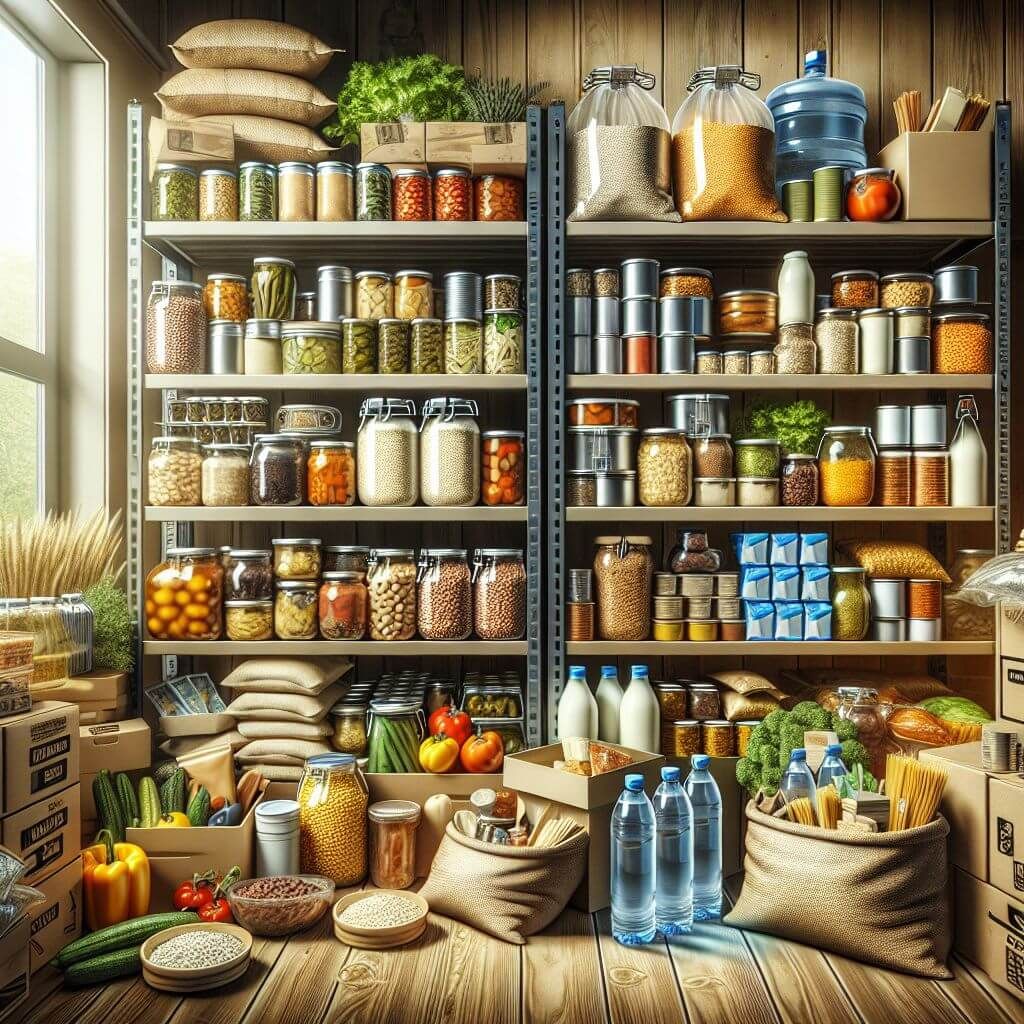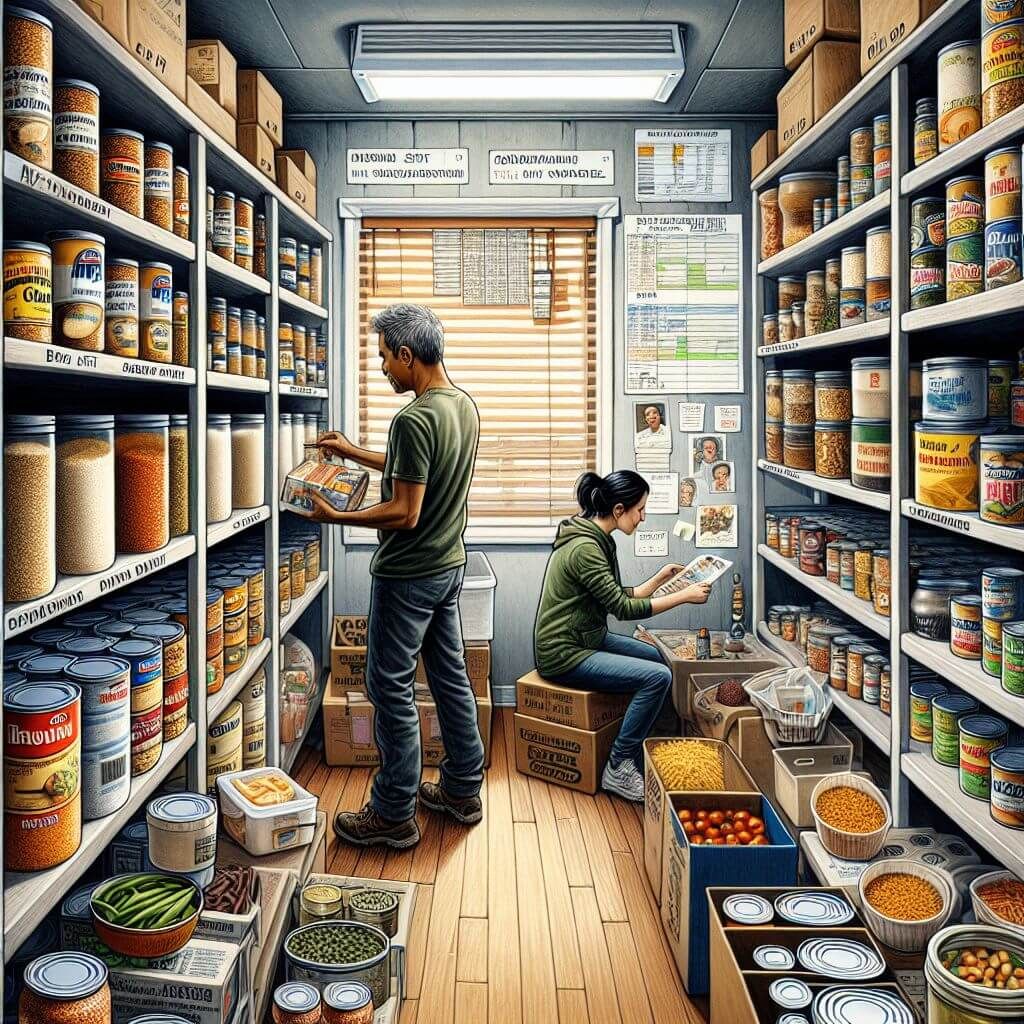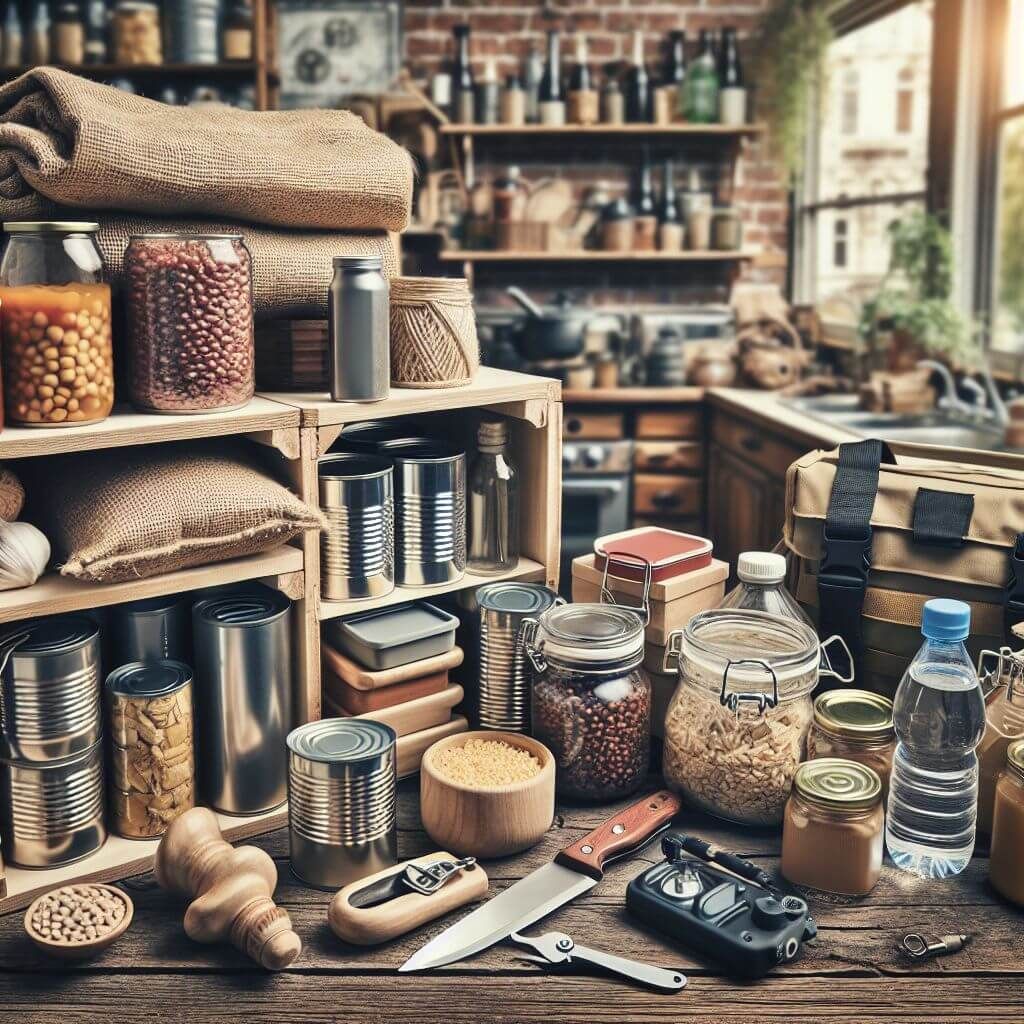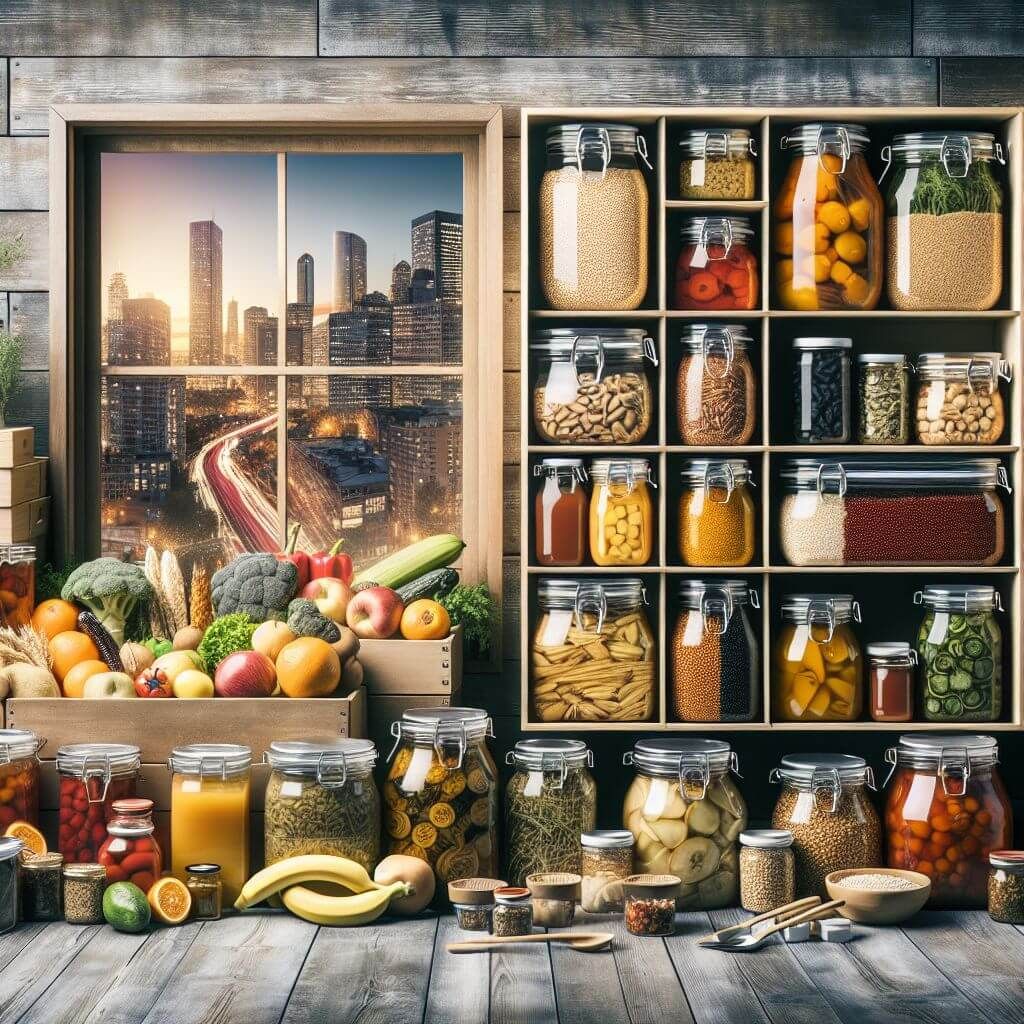
Key Takeaways
- Urban survival food storage is about smart selection, space optimization, and ensuring a long shelf life.
- Choose foods that are dense in nutrients, have a long shelf life, and require minimal preparation.
- Maximize space by using innovative storage solutions and organizing vertically.
- Regular rotation and monitoring of your food supply are crucial to maintain freshness and nutritional value.
- Security measures are necessary to protect your food reserve from pests and potential theft.
Stocking Up: Urban Survival Food Storage Essentials
Living in the city doesn’t mean you can’t be prepared for emergencies. In fact, it’s crucial to have a plan in place, especially when space is at a premium. Urban survival food storage is all about making the most of what you have. It’s about selecting the right foods, storing them efficiently, and ensuring they’re there when you need them most.
Why Food Storage Matters in Urban Settings
In an urban environment, you’re often at the mercy of supply chains and grocery store inventories. When the unexpected hits – be it a natural disaster, pandemic, or economic downturn – those once abundant shelves can quickly become bare. That’s why having your own supply of food is a non-negotiable part of urban survival. It’s not just about having enough; it’s about having the right kind that will last and provide you with the nutrition you need to keep going.
Criteria for Selecting Sustainable Food Storage Solutions
When choosing food for long-term storage, there are a few key factors you need to consider:
- Durability: The food must withstand time without spoiling.
- Nutrient Density: Choose foods that deliver high nutritional value to sustain you.
- Space Efficiency: In urban dwellings, space is limited, so opt for compact packaging.
- Preparation Ease: Look for foods that require minimal water and energy to prepare.
Optimizing Space: Storage Solutions for Tight Quarters

Space is a precious commodity in urban living. But don’t let a lack of space deter you from being prepared. There are plenty of creative ways to make the most of what you’ve got.
Utilizing Vertical Space: Shelves and Hanging Systems
Think upwards. By installing shelves and hanging systems, you can dramatically increase your storage capacity. Look for unused areas like over doors, under sinks, or even ceilings. A hanging pantry organizer, for example, can turn the back of a door into a mini storage area for lightweight items.
Innovative Containers for Compact Living
It’s not just about shelves. There are containers designed to fit into odd nooks and crannies of your home. Stackable, airtight containers can keep pests out and freshness in, all while fitting neatly together to reduce wasted space. Under-bed storage is another often overlooked opportunity to stash away your non-perishable food items.
The Pantry Essentials: What to Stock for Longevity

When it comes to selecting the backbone of your urban food storage, think about foods that have stood the test of time. Grains, legumes, and certain types of protein have been the foundation of human sustenance for millennia due to their durability and nutrient content.
Grains, Legumes, and Dry Goods: The Bulk Staples
Grains like rice, wheat, and oats are excellent for long-term storage because they pack a lot of energy in a small space. Legumes such as beans, lentils, and chickpeas are not only space-efficient but also rich in protein and fiber. When stored properly, these bulk staples can last for years without losing their nutritional value. Just make sure they’re kept in airtight containers, away from moisture and light.
Proteins: Canned, Freeze-Dried, and Jerky
Protein is essential for maintaining muscle and overall health. Canned meats, freeze-dried options, and jerky are all excellent protein sources that store well. Canned goods can last a long time, but you must keep an eye on the expiration dates and integrity of the cans. Freeze-dried meats are lightweight and can last even longer if sealed correctly. Jerky is a traditional method of preserving meat that, when stored in a cool, dry place, can be a savory source of protein.
Produce: Preserved Vegetables and Fruits
Vitamins and minerals are crucial, and you’ll need a good supply of fruits and vegetables. Canned options are readily available and last a long time, but you can also look into dehydrating your own for an even longer shelf life. Don’t forget to include a variety of types to ensure a range of nutrients.
Food Preservation Techniques for Urban Preppers
Preserving your own food can be a rewarding way to prepare for the unexpected. Not only does it allow you to store what you love, but it also gives you control over the ingredients and the process.
DIY Dehydrating: The Basics
Dehydrating food is a space-saving way to preserve it. By removing moisture, you inhibit the growth of bacteria and mold. You can dehydrate fruits, vegetables, and meats with a simple dehydrator or even in your oven. The key is low heat over an extended period.
- Wash and prep your food by cutting it into thin, even slices.
- Spread the slices out on dehydrator trays or a baking sheet if using an oven.
- Set the temperature between 130-160°F (54-71°C), depending on the food.
- Check regularly until the food is dry but still pliable.
Once your food is dehydrated, store it in airtight containers in a cool, dark place to maximize shelf life.
Mylar Bag Sealing and Vacuum Packaging
Mylar bags paired with oxygen absorbers can significantly extend the shelf life of your food. They’re light-proof, moisture-proof, and provide a superior barrier to gases. Vacuum sealing removes air, which also extends shelf life and saves space. Both methods are great for urban preppers with limited storage areas.
Maintaining Your Urban Food Reserve

It’s not enough to just stockpile food; you have to maintain it. This means keeping a watchful eye on what you have and ensuring it’s ready when you need it.
Regularly Rotating Supplies
Make it a habit to use and then replace items from your storage. This practice, known as ‘first-in, first-out,’ ensures that nothing goes to waste and that your stock is always fresh. It also helps you become familiar with the foods you’ve stored, so you know how to prepare them when necessary.
Monitoring Expiry Dates and Quality Control
Keep a log of expiration dates and inspect your food regularly. If cans become dented, swollen, or rusted, discard them. With dry goods, watch for any signs of moisture or pests and take action immediately if you find any.
Preparing for the Unexpected: Extending Your Storage Life
It’s all about creating the right environment and using the right techniques to ensure your food lasts as long as possible.
Using Oxygen Absorbers and Desiccants
Oxygen absorbers can greatly extend the shelf life of your food by preventing oxidation. Desiccants, on the other hand, absorb moisture that could lead to spoilage. Both are inexpensive insurance policies for your food storage.
The Importance of Climate Control
Maintaining a consistent, cool temperature is vital for food storage longevity. Avoid placing food near heat sources or in direct sunlight. Even in an urban apartment, you can find spots that remain relatively cooler, such as lower cabinets or closets.
Food Storage Security Measures
Your food reserve is your lifeline in an emergency, and it needs to be protected as such.
Protecting Your Supply from Pests
Use sturdy, pest-proof containers and keep your storage area clean. Regular inspections for signs of infestation can prevent pests from getting a foothold.
Discretion and Protective Storage
It’s important to be discreet about your food reserves. In times of scarcity, a well-stocked pantry can become a target. Consider concealing your storage or using unmarked containers to blend in with your regular household items.
It’s important to be discreet about your food reserves. In times of scarcity, a well-stocked pantry can become a target. Consider concealing your storage or using unmarked containers to blend in with your regular household items. For more guidance, read about underground survival gardening as a method to keep your food reserves safe.
Scale Up: From Surviving to Thriving
Building your urban survival food storage is not just a one-time event; it’s a continuous process. As you become more comfortable and knowledgeable about what works best for you and your space, you can scale up your efforts. Start small if you need to, but don’t stop there. Your goal is to create a sustainable system that supports you and your family over the long term.
Expanding Your Food Storage Over Time
As you rotate through your current supply, take note of what you use most and what you could do without. This will help you tailor your storage to your actual needs. When you have the basics covered, begin to add variety to your pantry. Include spices, oils, and other condiments that can make meals more enjoyable. Over time, you can also look into growing your own herbs or vegetables, even in a small space, to complement your stored food.
Besides that, consider investing in larger quantities of your staple items when they’re on sale. This strategy not only saves money but also ensures that you’re well-stocked for the future. Always keep an eye out for new products and technologies that can help extend the life of your food storage or make it more efficient.
Community and Networking for Resource Sharing
Remember, you’re not in this alone. Building a network within your community can be a game-changer. By connecting with neighbors, you can share resources, knowledge, and even bulk purchases to save on costs. In an emergency, a community that works together is much more resilient. Just be sure to engage with others in a way that maintains the security of your own food supply.
Frequently Asked Questions (FAQ)
When it comes to urban survival food storage, there are always questions. Here are some of the most common ones, answered to help you on your way to becoming an urban prepping pro.
How Can I Store Food Long-Term in a Small Apartment?
Maximize every inch of space by using stackable containers and underutilized areas like under beds or above cabinets. Focus on calorie-dense foods that don’t take up much room, and consider multi-use furniture with hidden storage compartments. Being organized and creative with your space is key.
What Foods Have the Longest Shelf Life for Emergencies?
Some of the best foods for long-term storage include:
- Dried beans and legumes, which can last up to 30 years when stored properly.
- White rice, with a shelf life of 20-30 years.
- Freeze-dried fruits and vegetables, which can last 25+ years.
- Dehydrated powdered milk, with a 20-year shelf life.
- Honey, which never spoils if stored correctly.
How Do I Protect My Food Storage from Rodents and Insects?
Store your food in airtight containers made of sturdy materials like glass or metal. Regularly inspect your storage area for any signs of pests and keep it clean. Use bay leaves or diatomaceous earth as natural deterrents for insects.
For example, one of the most effective ways to protect grains and dry goods is by adding a couple of bay leaves to the storage container. The scent repels many common pests and can help keep your food safe.
Is it Cost-Effective to Build an Urban Survival Food Storage?
Building a food storage is an investment in your safety and well-being. By purchasing in bulk, looking for sales, and preserving food yourself, you can create a cost-effective and robust food supply. Consider the costs of not being prepared – in an emergency, prices skyrocket, and availability plummets.
How Often Should I Rotate My Food Storage?
It’s best to rotate your food storage regularly, ideally every six months to a year, depending on the shelf life of the items. Incorporate stored food into your regular cooking to keep the stock fresh. Always replace what you use to maintain a consistent supply.






